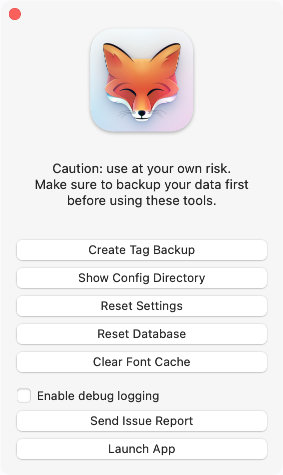Resetting the macOS font cache
The macOS font registration system is responsible for all activated fonts on your Mac. Clearing the macOS font cache will reset activated fonts and may resolve font activation or rendering issues.
The macOS font registration system
Whenever you activate a font, whether that’s through Typeface or any other font manager, that font gets added to a central macOS font registry. This is a database that keeps track of all activated fonts on your Mac. It includes various bits of information about the fonts, such as their location and their name. The fonts that are listed in this database are the ones that you can pick in your design apps.
Clearing the font cache may be necessary when you encounter certain problems with your fonts. For example, if applications are displaying the wrong font or you see question marks instead of characters, clearing the font cache can help resolve that. Similarly, if font activation in Typeface fails, or an activated font is not showing up in your applications, clearing the cache resets the font registration system such that you can try to activate them again without other fonts interfering.

It’s not always clear what could have caused a font cache issue. The font registration system may become confused when activating corrupt fonts or font duplicates. Using multiple font managers simultaneously could also cause issues. Or perhaps it was just an unlucky coincidence.
Note that the font cache is something that is used by all apps. If you only notice font issues in one app and not in others, it’s unlikely that the problem is related to the font cache. Clearing the cache is only necessary if you’re experiencing font activation or font rendering issues. There is no need to clear the cache if your fonts and apps are working properly.
Clearing the macOS font cache
To resolve font activation issues you can clear the macOS font cache. This will deactivate all fonts activated by Typeface and other font managers. After resetting the cache only system fonts and fonts located in /Users/<username>/Library/Fonts will stay activated. So make sure to store your currently activated fonts to a tag if you’d like to restore them later.
To clear the macOS font cache follow these steps — note that you need to restart your Mac afterwards:
- Close Typeface
- Hold down the Option key and launch Typeface. Keep pressing Option until you see the support tools.
- Choose the option and confirm
- Restart your Mac

Restoring system fonts
Clearing the cache will deactivate user fonts, but all fonts located in the standard macOS font folders will remain activated. This includes system and user fonts that are stored in the following folders:
- /Users/<username>/Library/Fonts - default location for user fonts installed using Font Book.
- /Library/Fonts - fonts available to all users on your Mac, typically contains fonts provided by third party applications.
- /System/Library/Fonts - contains macOS system fonts.
If any of these folder contains a corrupt font or duplicate that causes the activation issues, then clearing the cache will not help, since all font files stored in these folders are always activated by macOS.
In that case you can fully reset all fonts and restore the original fonts included with your Mac. Restoring the standard fonts moves any custom fonts you’ve installed into a separate folder, which makes them unavailable to use in apps.
The steps for restoring standard fonts depends on your current macOS version. For macOS Ventura follow these steps:
- Open Font Book
- Choose >
- Click Advanced
- Click Reset Fonts and confirm
More information, including instructions for other macOS versions, is available in the Font Book User Guide